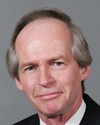Good afternoon, ladies and gentlemen.
It's a real honour to be here this afternoon to speak to you about a little town in southern Alberta with two OK's.
As I was flying across this beautiful land last night and somewhat lamenting the absence of one Canadian hockey team in the Stanley Cup playoffs, I was thinking about the abundance of resources or the lack of resources in this country and how that is constantly challenging Canadian ingenuity in terms of how we manage our affairs. I'd like to provide you with a very brief overview of how one community in southern Alberta has decided to manage its affairs relative to natural resources.
To give you context, our community is located a brief 20 minutes from Calgary--45 minutes on a bad day. We're located within the South Saskatchewan River basin, with the beautiful Bow River that flows through Calgary. There are a series of rivers from the mountains that feed that, including the Sheep River, which flows through our community.
Alberta has come to the realization that the water supply in our province is diametrically opposed to our settlement patterns. Seventy percent of the population of Alberta lives in southern Alberta and thirty percent of the water supply is in southern Alberta. In part, that's at the root of the situation our community has faced with respect to managing growth.
I'd also like to give you a little context on managing growth. As you all know, Alberta is in a heated economy right now. When I went there in 1988, our community was about 4,000 people. In the 1996 federal census, Okotoks was 11,500, and the recently announced census has us at well over 17,000--a 50% increase in growth. We're managing within the context of a very growth-oriented community. We're a community of 17,000 people that issued 1,000 building permits for new homes last year. That is about a 20% growth rate.
I'd like to share a vision of sustainable Okotoks and provide you with a bit of a background as to why we became, and are becoming, a sustainable community.
I spoke about the Sheep River, which is the heart of our community, and the fact that it flows through our community. It is one of those pristine mountain-fed rivers that is untamed by man. If you'd been in our community in June 2005, you would have seen how untamed it can be. We had three record floods in the month of June. We're fortunate from a geographic point of view, because we have a relatively constrained river valley. In the early settlement days, if you were flooded in the spring you moved to higher ground. Fortunately, most of those folks on the flood plain moved to higher grounds, so we have minimal settlement patterns within the flood-plain area. As you can see from the air photo in your package, we're a community that's split by the river that runs in an east-west direction. About half of our population growth is on the north side and half is on the south side.
In 1995 our community was at a crossroads. It was partly as a result of government-imposed legislative requirements for communities in Alberta to come up with new, long-term planning frameworks to deal with growth management, as well as inter-municipal planning issues because the Province of Alberta had chosen to abandon the regional planning system. Our community was faced with the challenge of either the traditional planning of growth without limits or choosing a different route. That route ended up being a planned destiny, a route that is premised on living within the natural carrying capacity of our environment, i.e., the Sheep River. The Sheep River is a very sensitive and important aquatic habitat for fisheries. During certain periods of the year there are times when flows are very low, so the amount of water you can withdraw from shallow aquifers is limited relative to its impact on aquatic habitat.
Why be a sustainable community? When Okotoks adopted its plan in 1998, it became one of the first municipalities in the world to actually establish growth targets that were limited to infrastructure and environmental carrying capacity. As I explained, we've done that in part as a result of a water supply issue and in part as a result of a desire by a community--a fundamental right of communities--to manage and plan its own destiny. Our community said that we very much want to maintain that small-town community and asked how we go about doing it within the context of corporate limits and urban densities and growth management and pressures.
There is a commitment from our community. As you can see from the slide entitled “Commitment”, the percentages there speak to survey results of our residents from 1996 and their support for the initiatives we have in place. You can see resounding support for the town's move to sustainability, for awareness, for water conservation and for recycling.
We have created a population limit, often referred to as a cap. In essence, we have a build-out boundary established by virtue of lands annexed into our corporate limits. As applies to any Canadian municipality, if an urban municipality annexes lands, they have a duty in law to provide for highest and best use. If you want to limit your growth relative to carrying capacity, or whatever the case may be, you have to stop annexing lands and then live within those built-up boundaries. In many metropolitan areas, one urban boundary meets another, so there are many examples across Canada where communities have, by default or purpose, limited their boundaries. There are not many examples where folks have done it by way of a planned destiny.
The measures of our success and our decision-making are premised on four foundations: environmental stewardship, economic opportunity, social conscience, and fiscal responsibility. With those come hard targets. And if there is one lesson we've learned, it's the articulation of hard targets with respect to your goals. It's essential that you articulate those at the early stages and move towards them.
So you can see that we talked about a build-out population. We talked about distribution of the population. And we talked about something that is important for our community from a fiscal responsibility point of view, and that relates to the assessment ratio of residential to non-residential. As I'm sure you folks know, the more non-residential assessment there is, the greater the ability of municipalities to generate revenues to service their residential population.
We talked about densities. We talked about water consumption, because to grow to our build-out limit—that population extrapolation of 25,000 to 30,000—we've actually had to reduce per capita water consumption by 30% from 1998 levels. And I'll get to that in a minute.
In terms of strategic growth management, we have developed clear targets well in advance. There has been a gradual, managed evolution, and there has been extensive consultation with the development industry to make this sort of thing happen. There have been no significant annexations, and there's been a 15- to 20-year build-out—and at today's rate, that might be a 10- to 15-year build-out.
Of course, good governance, as I'm sure you folks are all aware, is essential in terms of engagement with citizens, in terms of participation and in terms of nurturing a safe and caring community.
As for some of the results, I know that one of the topics you're studying is the greening of electricity in Canada, so I'd like to speak to a couple of special projects we've done within the context of fiscal responsibility for the municipality, environmental stewardship, etc.
In terms of solid waste management, this is a community that's grown from about 7,000 people to 17,000 people between 1991 and 2006. So keep in mind when you're looking at those numbers, the context is more than a doubling of the population.
On solid waste management, we have one of the most extensive recycling programs in Alberta, if not Canada. Our program—as Barbara mentioned about Sudbury—is premised on getting into the schools, educating our children, who go home and tell their mom and dad why a pop can shouldn't be thrown in the garbage and should be recycled.
With respect to solid waste management, on the next chart you'll see that we've actually begun to track the recycling tonnage we've processed. As you can see, between 1991 and 2006 there's been a steady increase in the tonnage. The interesting statistic from that is that if you take into account processing fees, there have been 1,912 tonnes of recyclables received and diverted, equating to about $1.5 million in savings, both in terms of tonnage and processing fees. So conservation and resource management can pay off as well.
When I moved to Okotoks, our resource recovery team consisted of two operators picking up garbage on a daily basis over a five-day period. We've more than doubled the population and we still have two operators. You do that through education, through limitations on curbside waste, through accessibility and convenient recycling facilities. This saves money at the end of the day, and this extends the life of your landfill, etc.
On the next graph, we simply show what the total tonnage would have been if we hadn't diverted the recyclables versus the actual tonnage with the recycling.
Now, in terms of energy efficiency, there was a recent highly favourable news item on CBC with respect to some work Okotoks has done around energy management, because we've taken advantage of the abundance of solar energy available to our community and put together a number of solar applications. You may not be aware—though I'm sure Mr. Richardson is—that southern Alberta receives more solar thermal energy in the months of May through November than Miami, Florida. The challenge is how do you capture that and how do you use it for your heating season? I've got a couple of interesting projects we've undertaken in that regard.
Many of our initiatives, however, couldn't have taken place without the deregulation of Alberta's electricity and natural gas markets. Ironically, it's the regulated side of these utilities that's having a hard time keeping up with electrical transmission. Alberta's deregulated electricity approach, we're told, has resulted in the highest per capita build of low-impact renewable energy in Canada, with no direct provincial support through subsidies to the generator. Indeed, it's our view that subsidies do not promote conservation.
Okotoks, in the late nineties, because of concern about deregulation of electricity, got together with the Alberta Urban Municipalities Association and went out to the marketplace and aggregated our electricity load. In our first aggregation of electrical consumption for urban municipalities in Alberta, the green percent component stipulated in the aggregation was 2%, and that came at 100% premium in terms of cost in the marketplace. We recently went out for a second aggregation, and I'm pleased to say that as of a week ago Monday, the Okotoks town council endorsed having 80% of all electricity consumption in Okotoks sourced from certified renewable energy. These are renewable energy certificates issued by EcoLogo Canada, primarily through wind, in-river, and biomass generation. The deregulation of the electrical industry—creating the generation, the distribution, the transmission and the retail components—enabled municipalities to take their big load across the province and go into the marketplace and the futures markets and purchase that commodity. It also enabled us to stipulate a green component.
Every municipality in Alberta that participates has a baseline of certified green energy of 20%. Our community happens to lead at 80%—but that relates back to the targets I spoke about earlier. In 1998, our community said we were going to see a 20% reduction in greenhouse gas emissions from 1998 baseline levels. Well, that's a 20% reduction from 1998 and a 60% increase in population since then.
How does one go about doing that? You have to begin sourcing renewable energy sources to make that sort of thing happen. We also have engaged in considerable energy efficiency initiatives, with solar applications and retrofitting buildings, and many of the things that Barb spoke about in Sudbury. And communities across this land are doing it because it makes sense.
In our case, as a small community with an operating budget back in the late-eighties of perhaps $5 million, we received a rebate through the electrical regulator. My council of the day, in their wisdom, chose to put those funds into an eco-efficiency reserve and to utilize those funds for retrofits for energy efficiency purposes, and to take the differential between the budgeted energy expenditure and the savings and pour that back into the eco-efficiency reserve, creating seed money for further retrofits. That's how we, as a small municipality, began to finance the initiatives that have resulted—as you can see on the energy efficiency chart—in a very modest 10% increase in natural gas consumption between 1998 and 2006, and a significant increase in electrical consumption. It's almost 50%—again, between 1998 and 2006. Keep in mind this takes place while you're doubling and, in some cases, tripling your municipality and installing new recreation facilities, libraries, fire stations, etc.
At the same time, we're pleased and proud to say that based on electricity and natural gas consumption, we've actually reduced our greenhouse gas emissions by 15% from 1998 levels. So we're not quite there, but our council just increased it to 80% green, and we believe that will get us there.
So we've had a 20% reduction in greenhouse gas emissions and a 60% growth in population—building footprint, street lights, motors, recreation centres, etc. So it can be done. You can go both ways. In our case we chose to go both ways through energy efficiency, through utilization of renewable energy sources, and through extensive and aggressive utilization of certified renewable electrical generation, which we're able to do in Alberta because of the deregulated environment.
We have also identified some charts in here—I won't get into detail, because I know my time is just about up—with respect to water management and the criticality of us reducing our per capita consumption, so we live within that natural environment.
Waste water management is a story we are very proud of, not just by way of the procurement process that we use, which was a “design, build, and operate”, but as well the results of it. There is a chart that reads “Treatment Results” in your package. It speaks to an incredible drop in terms of detected levels, the suspended solids, BODs, ammonia, phosphorous, etc.
We did all of that with the retrofit to a waste water treatment plant that was initially budgeted at $30 million. We also examined, by the way, a regional utility system to Calgary, and capital costs were comparable but operating costs were double. And then we looked at an alternative approach to procurement. We went to the marketplace and asked, “Is anybody out there interested in designing a waste water treatment plant, in building it, and in operating it under a 20-year contract?” That contract came in at $11.5 million. We took the savings between the $11.5 million and the $30 million and immediately poured it into expansion of our recreation centres, which is desperately needed, given the growth in our community. But these are the treatment results.
We can now say with certainty, and indeed the Government of Alberta will say it, that the Okotoks waste water treatment plant is the highest-efficiency and most effective treatment facility in Alberta. The quality of effluent we are putting back into the Sheep River—remember, living within that ecological footprint, that environmental carrying capacity—is better than the receiving stream.
There is a slide on “Drake Landing—A North American First”, and I'll briefly speak to this. As a result of the work we have been doing, some of the initiatives, the building of a sustainable community, living within an environmental carrying capacity, the Government of Canada took notice, the Federation of Canadian Municipalities took notice. We, and myself personally, have been on a number of energy missions to Denmark and to the Netherlands, to look at the application of technologies, solar, wind, district heating system, cogeneration, electrical.
The city of Copenhagen, I'm not sure how many million people, has one furnace stack serving the whole community. It's amazing.
It can be done in Canada. It can be done in the North American context, but there are lots of challenges relative to the marketplace that you have to look at, and Drake Landing is the first. I must say that without the support and funding of the Government of Canada and Natural Resources Canada, this project would have never happened.
What we've done is we've built a 52-home demonstration technology innovation project. As that rancher said to me about a year ago, “about that solar sink you've built”, we capture this solar energy that's on the backs of these detached garages. We pump it underground. We use nature's crust as the thermos. We heat up the ground to well over 90 degrees Celsius, and then you extract that heat and you heat the homes in the winter.
The technology and the performance criterion is that a minimum of 90% of the space heating requirements of these homes is met through solar thermal energy. We also have solar hot water heating systems on each of the homes, and the performance specification on that is a minimum of 60% of the hot water heating requirements of those homes is from solar.
So that's one we're very proud of. We're just commissioning it. The challenges associated with that and the support we've received from the Government of Canada, the Government of Alberta, from Climate Change Central, from the partners that we have in place.... From a development point of view, it takes four years to charge this BTES, these boreholes that are into the ground, and providing a mini-utility operator that was prepared to take on that system was quite a challenge without there being demonstrated performance. You're dealing with European technology never tried in Canada.
It's not just consumer preference that's the issue, it's the technology and its performance. So we've actually created a not-for-profit corporation called the Drake Landing Company, which is composed of the four principal partners: the mini-utility company, which happens to be ATCO Gas, one of the largest natural gas distribution firms in western Canada, who are in the home heating business, and this just happens to be a different kind of home heating; the town of Okotoks; the developer, United Communities; and the home builder, Sterling Homes.
We as a partner have a four-year program to develop and commission this residential neighbourhood to meet these performance standards, after which ATCO will take over.
So what have we learned? We've learned that you have to leap outside the box. You have to articulate a clear and concise vision. You have to make your goals tangible and deliverable. You need to continuously revisit your goals as a community, whether the community of Okotoks, the community of Alberta, or the community of Canada. You have to go back and talk to your constituents continuously. Remember, we were a community of 7,000 people in 1998, and now 17,000. So over half of the community is new. So your community has to continuously revisit its vision, its priorities, etc. We are now at the point, as you can see from the statistics in the survey, where there is overwhelming support.
We knew as we went down this road less travelled that it would be very difficult to turn around and say we've given up on this notion of just growing to our natural carrying capacity, because the community is of a mindset—and that's the vision the community has for itself.
You have to make sustainability a business that you're in. It is not a “department of”.... And you have to adapt and have to learn from others.
As a leader in sustainable development, the Town of Okotoks is choosing to make broad and comprehensive choices that recognize a strong reciprocal relationship between the environment and community development.
A sustainable Okotoks does not wax nostalgic; rather, it represents a desire for a better community, in the form of a practical working guide to follow along a community development path.
As Mr. Churchill said back in World War II, “You make a living by what you get; you make a life by what you give.” In our opinion, these initiatives are certainly giving something to future generations.




